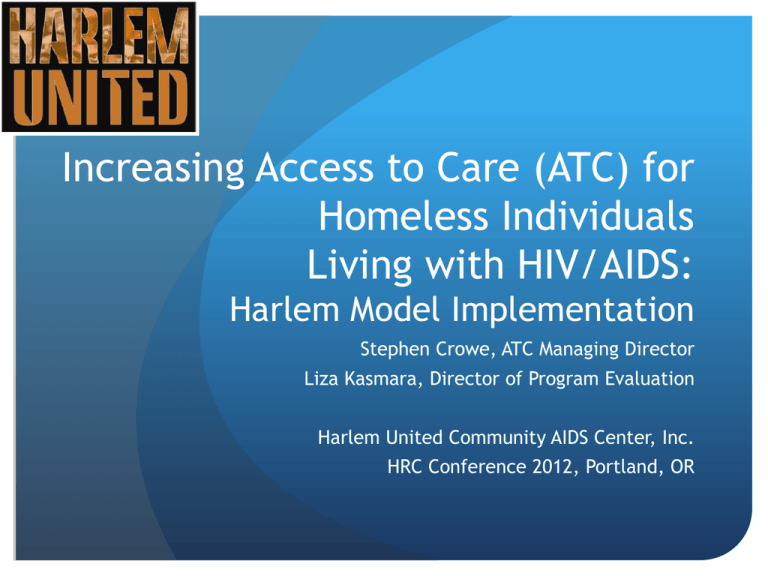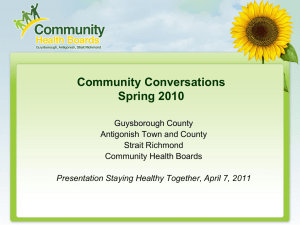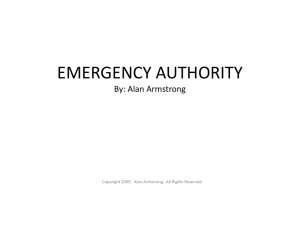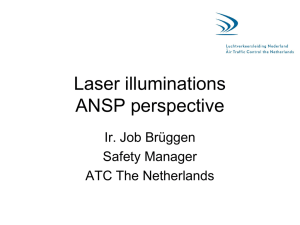Increasing Access to Healthcare Services for Homeless Individuals
advertisement

Increasing Access to Care (ATC) for Homeless Individuals Living with HIV/AIDS: Harlem Model Implementation Stephen Crowe, ATC Managing Director Liza Kasmara, Director of Program Evaluation Harlem United Community AIDS Center, Inc. HRC Conference 2012, Portland, OR Learning Objectives By the end of the session, participants will be able to: Identify barriers to linking and retaining patients in care List essential elements in a patient navigation system to increase access to and retention in care Understand the importance of care coordination Agency Overview Founded at height of first phase of AIDS epidemic: 1988. • Specifically to serve people living with HIV/AIDS (PLWH/As) who were homeless and/or suffering from mental illness and/or substance use. Agency of last resort for medically-underserved communities of color in Harlem. • Part of community-based movement to care for PLWH/As • Founded to address lack of response from established providers; • Responding to the unique personal, social, and institutional barriers to care in Harlem Organizational Structure INTEGRATED HIV SERVICES Adult Day Health Centers Food & Nutrition Supportive Housing (Women’s Housing, Transitional Housing, Congregate, etc. ) Health Homes (COBRA) Case Management Family Support COMMUNITY HEALTH SERVICES Community-Based HIV/STI/HCV Testing Holistic Provider-Led, Patient-Centered Primary Care and Dental Services Behavioral Health Services Patient Navigation/Case Management Support Access to Care & Support Services Drug User Health Services (Syringe Access, Harm Reduction, Recovery Support) Black Men’s Initiative – integrated interventions for YMSM, YTG of color New Business Development & Outreach Services Access to Care (ATC) & Support Services ATC Program Development National HIV/AIDS Strategy Reduce New HIV Infections Increase Access to Care and Improve Health Outcomes for People Living with HIV Reduce HIV-Related Health Disparities Achieve a More Coordinated National Response to the HIV Epidemic in the U.S. Access to Care (ATC) Model Ensure access to and retention in medical care Provide support services needed to achieve optimal health outcomes Facilitate re-entry into care and support services ATC Program Development • Testing team identified needs for Linkage to care (LTC) services for clients who tested positive • LTC “ninja” was created 2007 2010 • Conducted study to determine factors that predict retention in care • Found that LTC is one of the factors that predict retention in care • Integration of similar programs to reduce duplication of services • ATC program was established 2011 ATC Program Development Access to Care (ATC) & Support Services Case Management Services Patient Navigation Services Supportive Services (Entitlements, Housing Support, Tx Adherence, Mental Health) Outreach & Engagement Activities ATC Client Characteristics 75% Male, 24% Female, >1% Transgender 95% Black and Hispanic Primarily 35-54 years old 65-75% Homeless/Unstably Housed 40% HIV+, 15-20% AIDS diagnosis ATC Program Overview GOALS: SERVICES: • To locate and engage out-of-care individuals into care and support services • Supportive Case Management Services • Patient Navigation & Reengagement Activities • Support Groups (in English, Spanish & French) • Connection to Medical Care & Support Services • Psychosocial Assessments and Counseling (individual and group) • Health Education/Risk Reduction Counseling • Treatment Adherence Counseling (individual and group) • Housing Placement Assistance (individual and group) • Enrollment into ADAP/ADAP-Plus/APIC/Health Coverage • Entitlements Assistance • To ensure access and retention to medical care and support services • To provide support services needed to achieve optimal health outcomes • To navigate through initial medical care and connect to comprehensive case management ATC Program Current Model - Structure Managing Director AA/Data Entry Specialist LCSW Program Director Program Coordinator, Case Management Services Program Coordinator, Patient Navigation Services Program Coordinator, Support Services CM I CM II PN I PN II Sr. Program Enroller Housing Specialist I CM III CM IV PN III PN IV Treatment Adherence Specialist Housing Specialist II CM V CM VI PN V PN VI Outreach Specialist ATC Program Overview Target Population(s): • HIV-Positive and High Risk HIV-Negative Homeless Individuals • High utilizers of emergency rooms and detox facilities • Undocumented Immigrants Program Flow 1. PATIENT NAVIGATION SERVICES CLIENT IDENTIFICATION: Referrals, Out-ofCare individuals, Community Outreach, Internal Referrals Conduct record search: ePaces; correctional databases; eCW; HASA, AIRS, etc. REENGAGEMENT: Conduct home- visit, canvassing; phone calls; letters; outreach to providers SERVICE ORIENTATION: If located, a service orientation is completed and reconnection begins 2. SUPPORTIVE CASE MANAGEMENT SCREENING: Service Orientation; Screening for Insurance & Program Eligibility Target Area(s): • Harlem • South Bronx CLIENT SEARCH: INTAKE & ASSESSMENT: Service Plan Development SERVICE PLAN Referrals; Verification of medical appointment and services SERVICE PLAN UPDATE: 2 Medical Appts; PCSM; Reassessment; SP Update CASE CLOSURE: Connection to CM; Case Closure Summary 2A. PSYCHOLOGICAL ASSESSMENT ASSESSMENT: Completion of Psychosocial assessment by LCSW CASE CONFERENCE: CM staff and LCSW; in service plan; engage client in short-term counseling INIDIVIDUAL COUNSELING: 3 - 5 sessions with LCSW with connection to psychiatry services where applicable ATC Program Overview 2B. ENTITLEMENTS SCREENING: If HIV+: Screen for ADAP/ADAP Plus If HIV-: Screen for Medicaid APPLICATION: Verification of inactive Medicaid; Collect documentation for ADAP and Medicaid. APPLICATION SUBMISSION: Submit Completed Application; Verification of Application CASE CLOSURE: Ensure entitlement cards: Case Closure Summary 3. SUPPORTIVE SERVICES HOUSING ASSISTANCE •Housing Assessment •Housing Service Plan Development •Individual Engagements •Access to Educational and Support groups TREATMENT ADHERENCE EDUCATION •Tx Adherence Assessment •Development of Tx Adherence Service Plan •Case Conference with Medical providers •Individual Education •Access to Educational and Support groups SUPPORTIVE COUNSELING & RISK REDUCTION PLANNING •Minimum of 2 Risk Reduction Counseling Sessions •Interim supportive counseling; minimum of two sessions •Access to Educational and Support groups ATC Program: Outcomes Retention in care ART Status ART status among engaged ATC and non-ATC clients Retention rate among ATC and nonATC clients 88% 90% 80% 74% 80% 70% 70% 61% 60% 60% 50% 50% Not Retained 40% Retained 30% 71% 26% 39% 20% 10% 10% 0% Non-ATC (n=78) ATC (n=78) 0% Non-ATC (n=58) Not on ART On ART 29% 30% 12% 20% 40% ATC (n=69) ATC Program: Outcomes Viral load at baseline - ATC Viral load at follow up - ATC Undetectable viral load(<400) Undetectable viral load(<400) Detectable viral load (>=400) Detectable viral load (>=400) 15% 42% 58% 85% Viral load at baseline - Non-ATC Undetectable viral load(<400) Detectable viral load (>=400) Viral load at follow up - NonATC Undetectable viral load(<400) Detectable viral load (>=400) 33% 67% 42% 58% ATC and Primary Care Care Coordination Team meetings/daily rounds Electronic Reports Daily communication between outreach and office managers PN/Provider Protocols E-mails with daily reminders of appointment availability Patient Navigation/Escorts Case Management and Providers Communication via electronic health record Care Coordination Utilizing HU’s Electronic Medical Records, e-ClinicalWorks (eCW), to coordinate care: No show list Monthly review • Extraction of no show list (i.e. list of clients who consistently do not show up) from eCW • Submit no-show list to ATC program coordinators monthly • List is reviewed to determine clients in need of re-engagement activities • Patient Navigators conduct re-engagement activities for clients on no show list (e.g. phone calls, home visits, letters, etc) • Patient Navigators connect clients to care (i.e. escorts, checking Reengagement provider availability on eCW, tickler system) Care coordination Tickler system in eCW: • Action items in “Review Actions” feature • Serve as communication tool between PN and clinic • Useful for clients who have chronic noshow issues Challenges Difficulty locating clients who are transient or homeless Staff training & development, buy-in, resistance to change Paperwork integration (difficulty in minimizing duplication) Program funded by 6 contracts (city and state) is challenging to manage since funders have different core requirements, deliverables, expectations, and constraints Multiple points of entry Multiple databases Ensuring effective communication happens among all staff during process of program development Data entry issues (timeliness, not enough data entry support) Best practices & Lessons learned Employing Harm Reduction model Client-centered Approach Using Motivational Interviewing techniques to engage clients Low threshold services Using Daily Rounds to case conference clients Collaborations with internal programs and external agencies to recruit clients Ongoing staff training and development Minimizing duplication of intake and paperwork throughout entire process Contact Info Stephen Crowe, ATC Managing Director scrowe@harlemunited.org Liza Kasmara, Director of Program Evaluation lkasmara@harlemunited.org References Baggett, T. P. et al. (2010). The unmet health care needs of homeless adults: A national study. American Journal of Public Health, 100(7), 1326-1333. Barrett, B. et al. (2011). Assessing health care needs among street homeless and transitionally housed adults. Journal of Social Service Research, 37, 338-350. Bunger, A. C. et al. (2010). Defining service coordination: A social work perspective. Journal of Social Service Research, 36, 385-401. Carter, M. (2012). Majority of HIV-positive patients in US not receiving regular medical care. AIDS Map. Retrieved from www.aidsmap.com/Majority-of-HIV-positive-patients-in-US-not-receiving-regular-medical-care/page/2228542/ Craw, J. et al. (2008). Brief strengths-based case management promotes entry into HIV medical care. Acquir Immune Defic Syndr, 47(5), 597-606. Craw, J. et al. (2010). Structural factors and best practices in implementing a linkage to HIV case program using the ARTAS model. BMC Health Services Research, 10(246), 1-10. Dudley, J.R. (2009). Social work evaluation: Enhancing what we do. Charlotte, NC: Lyceum Books, Inc. Findley, S. E. et al. (2012). Building a consensus on community health workers’ scope of practice: Lessons from New York. American Journal of Public Health, 102(10), 1981-1987. Frerich, E. A. et al. (2012). Health care reform and young adults’ access to sexual health care: An exploration of potential confidentiality implications of the Affordable Care Act. American Journal of Public Health, 102(10), 18181821. Hwang, S. W. et al. (2010). Universal health insurance and health care access for homeless persons. American Journal of Public Health, 100(8), 1454-1461. Torian, L. V. et al. (2011). Continuity of HIV-related medical care, New York City, 2005-2009: Do patients who initiate care stay in care? AIDS Patient Care and STDs, 25(2), 79-88.









